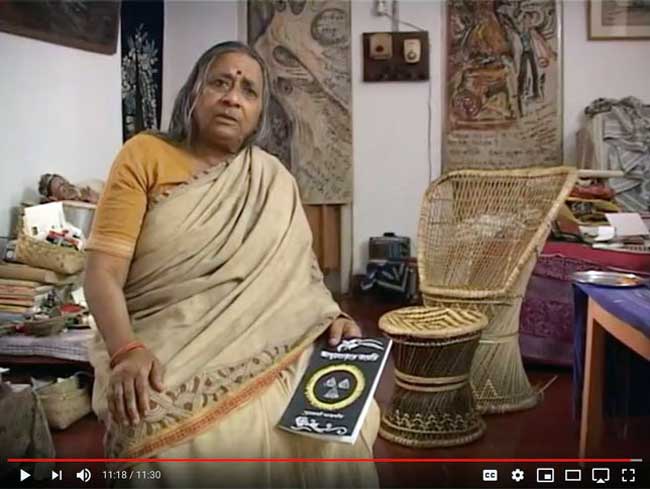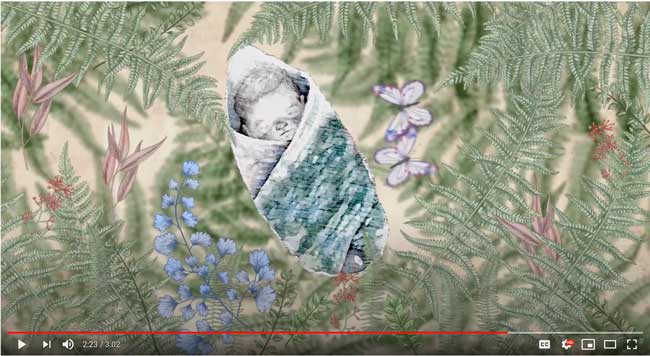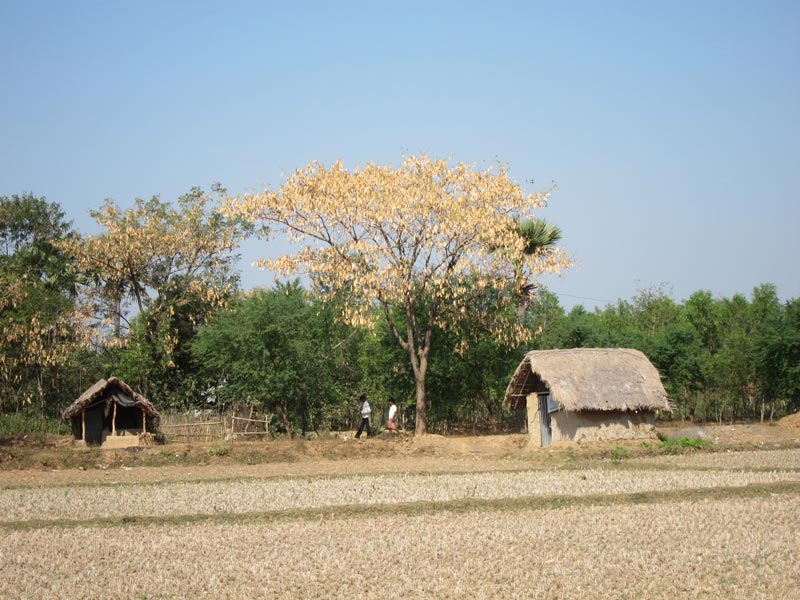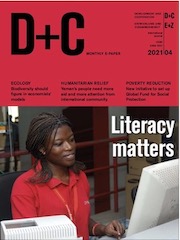
Shyamali Khastgir, June 23 1940 – August 15 2011
Shyamali Khastgir, who died on Independence Day 2011 after suffering an earlier stroke, transmitted her passion for life most expressively through her eyes. Her look was direct, searching and was described by some as dhukko (sad). It was also beautiful, reflecting the depth of her love of life and for all living, and the intensity with which she cared about a future in which she would take little direct part.
The daughter of painter and sculptor Sudhir Khastgir, a prominent member of the Bengal School of Indian Art, and of a mother who died tragically when Shyamali was very young, she grew up in DehraDun and was educated at Santiniketan. At the age of 21 she married Tan Lee, and the family lived in Kolkata where their son, Ananda, was born in 1966. Following a move to western Canada associated with Tan Lee’s work, Shyamali began to reflect on the environmental and human costs of economic and military development, becoming active in various groups sharing these concerns. She integrated these interests with her own background, seeing the relevance of Gandhi and Tagore to both the objectives and mode of dissent being practiced, and devising a unique style of cooking that integrated locally derived ingredients with aspects of Indian cuisine. […]
The influence of Tagore was further evident in the creative ways in which she expressed her varied commitments. A talented artist herself, she created posters that conveyed her convictions with striking force, and devised puppet shows that transmitted her messages to many who would not have received them otherwise. In this, as in all her life, Shyamali reached out to others without prejudgment or distinction, and for this she won the abiding affection of many. […]
Source: The Indian Express, Sun Mar 15 2009

Shyamali Khastgir on ill effect of nuclear power
https://www.youtube.com/watch?v=G9cnU-2WMgI
Artist and activist Shyamali Khastgir began to reflect on the environmental and human costs of economic and military development, becoming active in various groups sharing these concerns. She integrated these interests with her own background, seeing the relevance of Gandhi and Tagore to both the objectives and mode of dissent being practiced >>
Shyamali Khastgir took to the medium of art to train young minds to appreciate nature and work for the preservation of environment, among other things. Piyasree Dasgupta finds out more […]
“I was extremely shocked when India first tested a nuclear weapon,” she recollects.
So, Khastgir, who is also known as a peace activist, kept frequenting India even during her stay in America. She decided that she wanted to come to India and help people discover “invention” in better ways than making bombs.
“My father was an art teacher in Dehra Dun and I was sent to Santiniketan to study. He had great faith in Tagore and Nandalal Bose’s idea of education,” she reminisces. So, when Khastgir, then divorced, finally returned to India, she decided to spread her message through what she knew best — art. […]
“Education through liberal arts is something that’s still catching up in India and West Bengal, especially, though Santiniketan used to be a seat of the same in the past,” she explains.
She hopes, and so do we, that she succeeds in teaching the generations to come, ways of using creativity in a positive way.
Source: For peace on earth – Indian Express
Address : http://www.indianexpress.com/news/for-peace-on-earth/434672/0
Date Visited: Sat Feb 23 2013 12:21:49 GMT+0100 (CET)
Learn more about Santiniketan artist and activist Shyamali Khastgir >>
“The smart boy or clever girl who is deprived of the opportunity of schooling, or who goes to a school with dismal facilities (not to mention the high incidence of absentee teachers), not only loses the opportunities he or she could have had, but also adds to the massive waste of talent that is a characteristic of the life of our country.” – Nobel Awardee Amartya Sen in The Argumentative Indian (Penguin Books, 2005), p. 344 | Find this and other books published in India >>
Related: Tribal Children’s Right to Education | Childhood | Ekalavya (Eklavya, Eklabya), EMR & Factory schools | Childrens rights: UNICEF India >>
Book synopsis (Bengali publication)
SHYAMALI KHASTGIR
Swapner Santiniketan O Anyanyo RachanaShyamali, the daughter of sculptor-painter Sudhir Khastgir and student of pedagogue Acharya Nandalal Bose had been brought up with the background of the teachings and ideals of Santiniketan which she followed throughout her life. But the Santiniketan she dreamt of was never supposed to be confined within the geographical boundaries only. Even harsh protests used to come out of her every time she noticed any deviation occurring there. This book reflects her comprehensive views regarding her very own Santiniketan.
112 pages, 1st Edition [2013]
ISBN: 978-93-80542-34-8Price Rs. 100.00
Source: Monfakira publishing (“non-academic, rather experimental”)
URL: https://www.monfakira.com/?s=Shyamali+Khastgir
Date visited: 22 March 2020

Watch “The Good Ancestor – The Legacies We Leave” (3 min.): An animation that explores the legacies we might leave for future generations >>
Links to some of the most important organisations, thinkers and doers that are leading the way and that have inspired the book The Good Ancestor by Roman Krznaric >>
Related posts

Photo © Ludwig Pesch
Learn more about a wide range of issues
including Education and literacy, Health and nutrition & Ethnobotany >>
UNESCO World Heritage Centre | Backup: PDF-Repository >>
Santali is one of India’s many Adivasi languages. Today, seven different alphabets are used to write in it. Some argue that this great variety does not help the community’s development. | Read the full article by Boro Baski (3,3 MB) | Backup: PDF-Repository >>
Among South Asian Adivasis, we are the largest homogenous group. More than 10 million people belong to Santal tribes in India’s eastern states as well as in Bangladesh and Nepal. Our tribes are outside the Hindu caste system and have been marginalised historically.
Santali, for example, has survived and evolved over the millennia in oral tradition. It is an Austro-Asiatic language that is related to Vietnamese and Khmer, but not to the Indo-European languages prevalent in our part of South Asia.
In the 1890s, Christian missionaries found it helpful to write in Santali. They used Roman (Latin) letters. This alphabet, of course, has been used in many parts of Europe since the days of the Roman Empire.

Related posts >>
Education began to spread among Santals, and was not only driven by Christian missionaries. Typically, people opted for the scripts that were predominant in the region. Where most people speak Bengali, Santals used the Bengali alphabet. Where Hindi or Nepali are more common, they opted for Devanagari, which is related to, but differs from the Bengali alphabet. Where Oriya is the lingua franca, however, that language’s script was chosen, which is entirely different.
The sad truth is that Santali language and literature started to develop in six different scripts. To some extent, those alphabets were modified to better suit our language, but none of them accurately reflects Santali phonemes. The more depressing problem, however, is that Santal writing in different alphabets does very little to unite our community across the regions. It neither helps us communicate among one another nor does it foster a stronger sense of self-confidence. […]
In West Bengal, most Santal children attend state schools where Bengali is the language of instruction. In the neighbouring states, other languages are prevalent. At the same time, Latin letters are still in use as well, not least because some of the books prepared early on by the missionaries are still in print. They are indeed very useful.
Things have become even more complicated in the past two decades because government agencies started to approve a seventh script. It is called Ol-chiki and was designed to more accurately represent Santali phonemes. Since the turn of the millennium, state institutions have been promoting this innovative alphabet consistently, and they now consider it the only legitimate way to write in Santali. […]
We want our young generation to be rooted in our specific culture and to have good opportunities to take their fate into their own hands. Using our language is essential. What alphabet we use in school, matters less. We tell our students about Ol-chiki – encouraging, but not forcing them to learn it.
Source: “Divided by scripts” by Boro Baski (D+C Development and Cooperation, e-Paper April 2021)
URL: https://www.dandc.eu/sites/default/files/pdf_files/dc_2021-04.pdf
Date visited: 7 April 2021
For decades, the Ol-chiki alphabet, which was invented to represent the Santali language, was largely irrelevant. That changed in the late 1970s.| Read the full article (3,3 MB) >>
The script had been developed in 1925 by Raghunath Murmu, an Adivasi intellectual. He wanted it to accurately represent the pronunciation of the language used by Santal tribe. […]
In 2004, Santali became one of India’s 22 official languages. No other Adivasi language has been granted that status. There now even is a Santali/Ol-chiki Wikipedia. [However] some Santals disagree with how the government is promoting Ol-chiki. They argue that other scripts are at least as useful, especially as they have a history of Santali literature. They consider Santali writing in any script to be valid. However, authors who do not opt for Ol-chiki are not even considered for the Government of India’s prestigious literary Santali Sahitya Akademi Award. The scenario is not entirely bleak however. As more teachers are trained to teach in Santali and more textbooks with Ol-chiki writing appear, educational results will improve. Moreover, there is scope for publishing the same Santali text in more than one script.
Source: “The pros and cons of Ol-chiki” by Boro Baski (D+C Development and Cooperation, e-Paper April 2021):
URL: https://www.dandc.eu/sites/default/files/pdf_files/dc_2021-04.pdf
Date visited: 7 April 2021
Two tribal villages in Bengal revive the Santali language
By Nandini Nair, OPEN Magazine, 13 January 2017 | To view more photos and read the full article, click here >>
PADA MURMU IS the kind of teacher any young child would be fortunate to have. Her eyes dance, her hands talk and her laughter soars as she attempts to engage every four-year-old in front of her. Seated under the sky which serves as a roof, and on gunny sacks that double up as chairs, these children are learning the Bengali alphabet. While most of the dozen-odd kids repeat after her, a few lose focus and play with the mud, drawing patterns and dropping pebbles. But even a casual observer will notice that this is an engrossed classroom. The students read the Bengali alphabet cards held out by Pada and recite ditties that she has taught them. This might seem par for the course in many schools, but here in Ghosaldanga, it is exceptional. Located around 170 km from Kolkata, just beyond the Kopai River, this is a rare Santali school. While any rickshaw waala from Santiniketan will tell you facts and fables about the connection between the Kopai and the great Bengali poet Rabindranath Tagore, Bengali is an alien language for these Santali students. And for native Bengali speakers, Santali is terra incognita.
Close to six million people in India speak Santali (2001 Census). It is spoken in Bihar’s Bhagalpur and Munger districts; Jharkhand’s Manbhum and Hazaribagh districts; Odisha’s Balasore district; West Bengal’s Birbhum and Bankura districts; and in parts of Assam, Mizoram, and Tripura. It is one of the few languages that is not particular to a single state, as Santali and its dialects (Karmali, Kamari-Santali, Lohari-Santali, Manjhi and Paharia) can be heard across the Chota Nagpur plateau. Interestingly, no one script is used for Santali. The Latin script is used in Bangladesh; Oriya script is used in parts of Odisha; the Ol Chiki script is used in certain pockets; and the Bengali script is used in Bengal. Santalis represent more than half (51.8 per cent) of the total Scheduled Tribe population of West Bengal. In the state only 40 per cent of Santals are literate (57 per cent of men; and a mere 27 per cent of women). These dry facts illustrate that while Santali is spoken by millions of people across eastern parts of India, its speakers remain outside the realm of letters, highlighting the importance of teachers like Pada. […]
For the students at Rolf Schoembs Vidyashram (RSV, locally also called the Ashram School), this non-formal Santal day school can make the difference between dropping out and flourishing. […]
The Ghosaldanga Adivasi Seva Sangha (GASS) that works with the tribal population of two Santal villages (namely Goshaldanga and Bishnubati) uses education as a tool to merge and stand out. GASS, along with the Bishnubati Adivasi Marshal Sangha, has been working in these two Santal villages for close to three decades. When they began, each village had only one student who had completed the madhyamik (secondary) examination. They were Boro Baski in Bishnubati village (who now runs the Ashram School) and Sona Murmu (the first student of the Ashram School and secretary of GASS). The efforts of Sona Murmu and Boro Baski have slowly changed the education system of these two villages, which have a combined population of less than 1,000 people.
The story of RSV is itself an example of serendipity and perseverance. […] By learning Bengali (the state language) through Santali (their mother tongue), the students of Ashram School carve a path to their future while preserving their past. Knowledge of Bengali will help them find employment, while the wisdom of Santali will keep them rooted. Boro Baski, who has translated Rabindranath Tagore’s Bengali play Raktakarabi into Santali and has composed several of the rhymes, says, “In Bengali schools, students learn only about Tagore and Gandhi. Not our own story. They are learning only how to become non-Santali. They learn that their future lies in the mainstream. In mainstream culture, there is no space to learn about their own cultures. But if they were to learn the Ol Chiki script, where will they go from here? That is why we teach them Bengali through Santali.”
Boro Baski, who studied at a missionary school and later at Visva-Bharati in Santiniketan, knows all too well the dangers of losing one’s language. While he was punished in school for speaking in Santali, today he is the most educated person in his village. At the Indian Language Festival Samanvay 2016, held in Delhi, he said, “For the Santalis, the survival of our language means the survival of our culture.” […]
In Bengali schools, students learn only about Tagore and Gandhi. Not our own story. They are learning only how to become non-Santali.
The two-pronged approach ensures that students at Ashram School-whether it is Jagdish who lives 5 km away, or Kolpi and Robina whose homes are closer-become bilingual, and thus independent. Sculpture and painting are part of the curriculum, as are dance and music. Santal students learn about their own history such as the Santal rebellion of 1855 against the British and the zamindari system; and their own freedom fighters such as Sidhu and Kanhu Murmu. The students even learn the English alphabet through song. They are taught ‘a’ looks like a pretty girl, while ‘b’ is a ladle to pour oil and ‘c’ is an open mouth. The alphabet book for the 80-odd students is bilingual, with every Santali word written alongside its Bengali counterpart, dadu (grandfather) is explained in Santali as gadam baba, and naach (dance) can be found cheek- to-jowl with the Santali enech. […]
Pada, the 22-year-old teacher, and a former student of RSV, attests to that. Speaking fluent Bengali she says, “Everything I knew, poetry, music, games, it was all in Santali. This school gave me a sense of community and I hope my students get to feel the same.” As a teacher, she believes that by learning Bengali through Santali, these students are able to find moments of co-relation.
Kalidasi Mardi, another teacher at the school, who also studied from KG to Class IV at RSV, echoes Pada’s sentiments. She is the first person in her family to be educated; today, she is a graduate of Visva-Bharati University. […] “The biggest problem is illiteracy. If there is one thing I want to see is that the future generations do not suffer like my parents did.“
Even while Pada acknowledges that it is essential that the Adivasi children learn the dominant language, she also asserts, “Bengali and Santali can’t really meet.” Why? With rehearsed ease, she explains, “When I teach my students, I try to stress that we need to remember that the central ideas about Santali culture is dance, music and poetry. There is no way Bengali dance and music can compare to Santali. We have a song for every situation. We feel money takes away from the enjoyment of life. But to earn a livelihood, people have to learn other languages.”
Pada’s answer, which panders to all the classical notions of ‘tribal’, can seem cookie-cutter and even cliché. But in this school and in these villages, one can trace the truth behind her sentiments. Bishnubati village, around 5 km from the school, is a place of delicate beauty. Walking through, it is easy to idealise, even exoticise, the settlement. The harvest has just been completed, the toil of the year lies piled in heaps. The paths are swept clean and no open drains can be seen. With the festival season around the corner, the huts are awash in a new coat of mud, and intricate painted flowers creep up the doorway. Even frescoes span a few of the houses in the main lane. Sanyasi Lohar, artist and teacher at RSV, rallied together a few of the villagers to create these panels of art that depict local festivals and scenes from daily life.
Here in Bishnubati, the conversations of Satyajit Ray’s last film Agantuk (The Guest) come to life. In the movie, the mysterious guest (played by Utpal Dutt) , claiming to be an anthropologist, says he has spent numerous years with the Adivasis of the country, be it Kols, Bhils, Nagas or Santals. In a heated exchange with a lawyer friend, the Guest says that living with tribals he has found that technology is not only a matter of science exploration, rather it is about hunting, weaving, farming and building a hut. When asked about the ‘taboos’ of tribal life, such as witchcraft and shamans, he says the Adivasi doctor with his knowledge of medicinal properties, saved his life. He retorts with defiance, “My biggest regret is that I am not a tribal.”
The debate about whether tribals should be kept separate or should be ‘assimilated’ and ‘mainstreamed’ dates back to the creation of the Indian state. At that time, Jawaharlal Nehru and the Government took the position that they should be allowed their isolation. But as GN Devy, author, professor, linguist and founder of Adivasi Academy at Tejgadh, Gujarat, said at a talk in 2013 titled ‘Why do the Adivasis want to Speak’, “Nobody asked the tribal does he or she want to be left alone, or assimilated.”
In early December, when Bengalis were just pulling out their monkey caps and digging into nolen gur, a seminar was held in Ghosaldanga village about the role of a community museum and its role in the education and development of Santals. The speakers at the event included Sushanta Dattagupta (former Vice-Chancellor of Visva-Bharati) and Kakali Chakraborty (Deputy Director, ASI). The conversations pivoted around questions of modernity and tradition, preservation and dynamism.
The Museum of Santal Culture in Bishnubati itself is a place of good intentions but hapless execution. It wears a new coat of white paint, but within its walls, the items (musical instruments, traps and nets, ornaments) lie listless and reveal no stories. Here one can see the dangers of ‘museumifying’ a culture; it moves from a pulsing living entity to a fossil behind glass. But the question arises: how is one to capture the essence of an oral culture, where memories have not been written down?
The answer is to be found back at the school. It is the end of the school day, the students pack their bags and head out to the world outside. Talking about her students and own experience at RSV, Kalidasi Mardi says, “The school has given me the ability to talk-that is the biggest thing.” The efforts of those like Boro Baski ensure that Santals are given a voice to tell their own stories.
Source: Santali: Talking Time | OPEN Magazine
Address: https://openthemagazine.com/features/dispatch/santali-talking-time/
Date Visited: Fri Jan 20 2017 09:56:47 GMT+0100 (CET)
[Bold typeface added above for emphasis]
Dr. Boro Baski works for the community-based organisation Ghosaldanga Adibasi Seva Sangha in West Bengal. The NGO is supported by the German NGO Freundeskreis Ghosaldanga und Bishnubati. He was the first person from his village to go to college as well as the first to earn a PhD (in social work) at Viswa-Bharati. This university was founded by Rabindranath Tagore to foster integrated rural development with respect for cultural diversity. The cooperation he inspired helps local communities to improve agriculture, economical and environmental conditions locally, besides facilitating education and health care based on modern science.
He authored Santali translations of two major works by Rabindranath Tagore, the essay “Vidyasagar-Charit” and the drama Raktakarabi (English “Red Oleanders”), jointly published by the Asiatic Society & Sahitya Akademi (India’s National Academy of Letters) in 2020.
Other posts contributed by Dr. Boro Baski >>
Ghosaldanga Bishnubati Adibasi Trust
Registration under Trust Registration Act 1982
P.O. Sattore, Dist. Birbhum
West Bengal-731 236
India
For inquiries on Santal cultural and educational programs, please contact:
Mob. 094323 57160
Learn more about the status and spread of Santali in different regions of India: Clarifications by Dr. Ivy Imogene Hansdak >>
Find up-to-date information provided by, for and about Indian authors, researchers, officials, and educators
List of web portals covered by the present Custom search engine
Ashoka Trust for Research in Ecology and the Environment (ATREE) – www.atree.org
Freedom United – www.freedomunited.org
Government of India (all websites ending on “.gov.in”)
Kalpavriksh Environmental Action Group – https://kalpavriksh.org
Shodhganga (a reservoir of Indian theses) – https://shodhganga.inflibnet.ac.in
Survival International – www.survivalinternational.org
UCLA Digital Library – https://digital.library.ucla.edu
Unesco – https://en.unesco.org
Unesco digital library – https://unesdoc.unesco.org
Unicef – www.unicef.org
United Nations – www.un.org/en
Video Volunteers – www.videovolunteers.org
WorldCat (“the world’s largest library catalog, helping you find library materials online”) – https://worldcat.org
To search Indian periodicals, magazines, web portals and other sources safely, click here. To find publishing details for Shodhganga’s PhD search results, click here >>
Search tips
Combine the name of any particular state, language or region with that of any tribal (Adivasi) community.
Add keywords of special interest (music, poetry, dance just as health, sacred grove and biodiversity); learn about the rights of Scheduled Tribes such as the “Forest Rights Act” (FRA); and the United Nations “Declaration on the Rights of Indigenous Peoples”, “Universal Declaration of Human Rights”, “women’s rights”, or “children’s right to education”.
Ask a question that includes “tribal” or “Adivasi”, for instance: “Adivasi way of life better?” (or “tribal way of life worse?”)
Specify any particular issue or news item (biodiversity, bonded labour and human trafficking, climate change, ecology, economic development, ethnobotany, ethnomedicine, global warming, hunter-gatherers in a particular region or state, prevention of rural poverty, water access).
For official figures include “scheduled tribe ST” along with a union state or region: e.g. “Chhattisgarh ST community”, “Himalayan tribe”, “Scheduled tribe Tamil Nadu census”, “ST Kerala census”, “Particularly Vulnerable Tribal Group Jharkhand”, “PVTG Rajasthan”, “Adivasi ST Kerala”, “Adibasi ST West Bengal” etc.
In case the Google Custom Search window is not displayed here try the following: (1) toggle between “Reader” and regular viewing; (2) in your browser’s Security settings select “Enable JavaScript” | More tips >>
Note: hyperlinks and quotes are meant for fact-checking and information purposes only | Disclaimer >>
Some clarifications on caste-related issues by reputed scholars >>